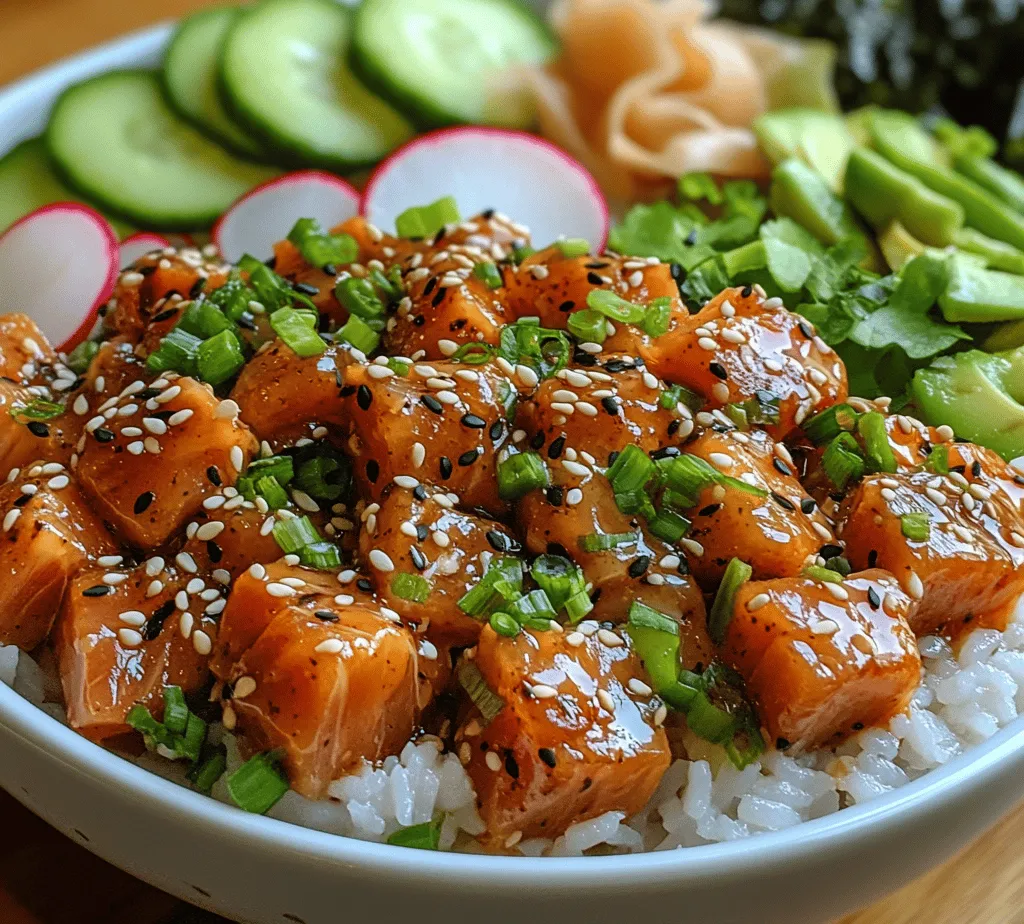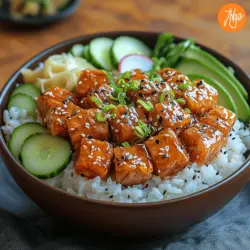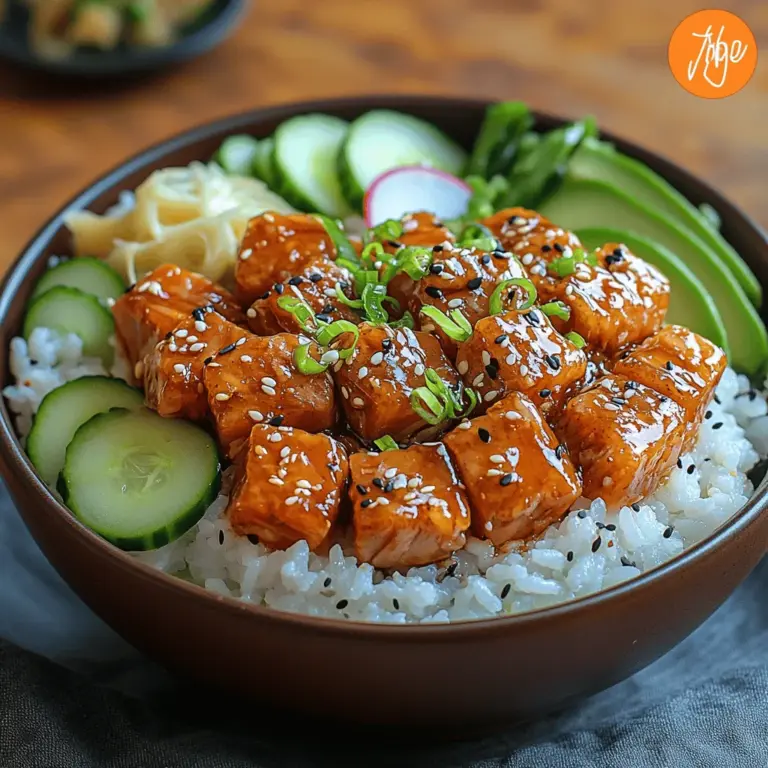Introduction
If you’re looking to bring a taste of Hawaii into your home kitchen, Aloha Tuna Poke Bowls are the perfect dish to try. Bursting with vibrant flavors and fresh ingredients, poke bowls encapsulate the essence of Hawaiian culinary tradition. These bowls are not only visually stunning with their colorful presentation, but they also offer a healthful and nutritious meal option that can be enjoyed any day of the week.
Originating from the Hawaiian term “poke,” which means “to slice or cut,” these bowls traditionally feature diced raw fish served over rice and topped with an array of fresh vegetables and flavorful sauces. The beauty of poke bowls lies in their versatility; they can be customized to suit various palates and dietary preferences. In this comprehensive guide, we’ll walk you through the steps to create your own Aloha Tuna Poke Bowl, ensuring that you can enjoy the delightful taste of Hawaii right at home.
Understanding Poke Bowls
Poke bowls have deep roots in Hawaiian culture, where they began as a humble dish among fishermen who would slice their catch and season it simply with salt, seaweed, and sometimes, onions. Over the years, this dish has evolved significantly, adapting to various culinary influences and preferences. Today, poke bowls have transcended their island origins and gained immense popularity worldwide, becoming a staple in urban dining scenes and health-conscious eateries alike.
Traditionally, poke bowls are characterized by their use of fresh, sushi-grade fish, often accompanied by a selection of seasonal vegetables. The dish showcases the natural flavors of its ingredients, enhanced by marinades and toppings that add depth and complexity. As poke bowls have become more mainstream, chefs and home cooks alike have taken creative liberties, introducing new ingredients and flavor combinations. This evolution reflects not just a culinary trend but also a growing appreciation for fresh, wholesome foods.
Ingredients Breakdown
To create a mouthwatering Aloha Tuna Poke Bowl, it’s essential to use high-quality ingredients. Below, we’ll break down each component that makes this dish a standout:
Sushi-Grade Tuna
The star of the Aloha Tuna Poke Bowl is, of course, the tuna. When selecting sushi-grade fish, quality is paramount. Sushi-grade tuna is sourced from reputable suppliers who ensure that the fish has been handled and stored in a manner that makes it safe for raw consumption. Look for bright red or pink flesh, which indicates freshness. Varieties such as yellowfin or ahi tuna are popular choices for poke bowls due to their rich flavor and firm texture. Always ensure that the fish is labeled as sushi-grade, and don’t hesitate to ask your fishmonger for recommendations.
Sushi Rice
Next, we have sushi rice, which is the foundation of any poke bowl. This short-grain rice is sticky and slightly sweet, making it perfect for holding together when served. Proper preparation of sushi rice is crucial to achieving the right texture. Start by rinsing the rice under cold water to remove excess starch—this step is essential to prevent the rice from becoming gummy. Cook the rice using a rice cooker or on the stovetop, following the package instructions for the best results. After cooking, it’s customary to season the rice with a mixture of rice vinegar, sugar, and salt to enhance its flavor.
Marinade Components
The marinade is what elevates the poke bowl from simple to sensational. A balanced marinade typically consists of several key ingredients:
– Soy Sauce: This salty, umami-rich component provides depth and flavor to the tuna.
– Sesame Oil: With its nutty aroma, sesame oil adds a unique richness to the dish.
– Rice Vinegar: This ingredient brings acidity and brightness, balancing the flavors in the bowl.
– Honey or Agave Syrup: A touch of sweetness helps to round out the marinade, creating a harmonious flavor profile.
Mixing these components together creates a marinade that beautifully complements the natural taste of the tuna.
Fresh Vegetables
To add texture, crunch, and nutritional value to your poke bowl, incorporating fresh vegetables is essential. Some popular options include:
– Avocado: Creamy and rich, avocado enhances the overall flavor and provides healthy fats.
– Cucumber: Crisp and refreshing, cucumber adds a nice crunch that contrasts with the soft fish and rice.
– Radish: These vibrant, peppery slices not only add color but also a zesty kick to the dish.
– Green Onions: Chopped green onions offer a mild onion flavor that ties the various ingredients together.
Feel free to experiment with other seasonal vegetables based on your taste preferences and availability.
Optional Ingredients
While the core ingredients are essential for creating a traditional poke bowl, don’t shy away from adding optional garnishes that can take your dish to the next level. Some popular additions include:
– Seaweed Salad: This tangy and slightly sweet salad adds another layer of flavor and texture.
– Pickled Ginger: Known for its palate-cleansing properties, pickled ginger can provide a refreshing contrast.
– Spicy Condiments: If you enjoy a bit of heat, consider adding sriracha, chili flakes, or spicy mayo to your bowl.
These optional ingredients not only enhance the visual appeal of your poke bowl but also allow you to tailor the dish to your liking.
Step-by-Step Cooking Instructions
Now that you have a clear understanding of the ingredients, let’s dive into the step-by-step process of preparing your Aloha Tuna Poke Bowl. We’ll start with the crucial step of preparing the sushi rice.
Preparing the Sushi Rice
1. Rinse the Rice: Measure out the desired amount of sushi rice (typically about 1 cup per serving) and place it in a fine-mesh strainer. Rinse under cold running water, gently swishing the rice with your hand to remove excess starch. Continue rinsing until the water runs clear.
2. Cook the Rice: Transfer the rinsed rice to a rice cooker or a medium saucepan. If using a rice cooker, follow the manufacturer’s instructions, adding the correct amount of water (usually a 1:1 ratio of rice to water). If cooking on the stovetop, add 1 cup of water for every cup of rice, bring to a boil, then reduce the heat to low, cover, and simmer for about 15-20 minutes or until the water is absorbed. Allow the rice to rest for 10 minutes off the heat.
3. Season the Rice: In a small bowl, combine 2 tablespoons of rice vinegar, 1 tablespoon of sugar, and 1 teaspoon of salt. Microwave for 15-20 seconds to dissolve the sugar and salt. Once the rice has rested, transfer it to a large bowl and gently fold in the vinegar mixture using a wooden spoon or spatula. Be careful not to mash the rice; you want to keep the grains intact while ensuring they are evenly coated.
Making the Marinade
1. Combine Ingredients: In a medium bowl, whisk together ¼ cup of soy sauce, 1 tablespoon of sesame oil, 1 tablespoon of rice vinegar, and 1 tablespoon of honey or agave syrup. Adjust the sweetness and saltiness to your preference by adding more honey or soy sauce as needed.
2. Taste Test: Before marinating the tuna, taste the marinade to ensure it meets your flavor preferences. You can add a little more sesame oil for richness or another splash of vinegar for acidity.
Marinating the Tuna
1. Prepare the Tuna: Cut your sushi-grade tuna into small cubes, approximately ½-inch in size. Ensure that your knife is sharp for clean cuts, which will enhance the presentation of the poke bowl.
2. Marinate the Fish: Place the cubed tuna in a medium bowl and pour the marinade over it. Gently toss the fish to coat it evenly, being careful not to break the cubes apart. Cover the bowl with plastic wrap and let it marinate in the refrigerator for about 15-20 minutes. This allows the flavors to meld without cooking the fish.
Once these initial steps are completed, you will be well on your way to assembling your Aloha Tuna Poke Bowl. The combination of sushi rice, marinated tuna, and fresh vegetables will come together to create a dish that’s not only delicious but also visually appealing. Stay tuned for the next part of this guide, where we’ll cover the assembly of the poke bowl and additional tips to enhance your culinary experience.

Marinating Process for Aloha Tuna Poke Bowls
Marinating is an essential step in preparing Aloha Tuna Poke Bowls, as it infuses the tuna with flavor while ensuring food safety. To start, you’ll need to prepare your marinade. A simple yet effective marinade consists of soy sauce, sesame oil, and a hint of lime juice, which not only enhances the taste but also helps in breaking down the fish’s proteins, leading to a more tender texture.
Once the marinade is ready, cut your sushi-grade tuna into bite-sized cubes, typically about ½-inch in size. It’s crucial to use sushi-grade tuna, as this type of fish is safe to eat raw and has been frozen to kill any potential parasites. Place the tuna cubes in a bowl and pour the marinade over them, ensuring each piece is well-coated.
Cover the bowl with plastic wrap and refrigerate for a minimum of 15 minutes. For optimal flavor, allow the tuna to marinate for 30 to 60 minutes. This duration is ideal as it lets the flavors penetrate the fish without compromising its texture. Remember, marinating any longer than an hour can lead to an overly soft texture due to the acidic lime juice in the marinade.
Assembling the Poke Bowls
Assembling your Aloha Tuna Poke Bowls is where the fun begins! Start with a base of rice, either sushi rice or brown rice, depending on your preference. For a visual appeal, use a shallow bowl to showcase the colorful ingredients.
1. Layer the Base: Scoop a generous portion of rice into the bottom center of your bowl. This will serve as the foundation for your poke bowl.
2. Add the Tuna: Once the tuna has marinated, use a slotted spoon to lift the cubes out, allowing excess marinade to drip off. Arrange the tuna aesthetically over the rice, either in a mound or spread out in a fan shape.
3. Incorporate Fresh Vegetables: Next, add your selection of fresh vegetables. Thinly sliced cucumbers, shredded carrots, and diced radishes not only add crunch but also a burst of color. Arrange these around the tuna, creating a vibrant rainbow effect.
4. Include Avocado: Slice a ripe avocado into thin wedges and fan them out on one side of the bowl. The creamy texture of avocado complements the firm tuna beautifully.
5. Sprinkle Toppings: Finish the base layer with toppings such as edamame, seaweed salad, or pickled ginger. These ingredients not only enhance the dish’s flavor but also add an interesting texture contrast.
Finishing Touches
Presentation is key when it comes to poke bowls. To achieve a professional finish, consider garnishing with sesame seeds, chopped green onions, and a drizzle of additional sesame oil or spicy mayo.
1. Sesame Seeds: Toasted sesame seeds add a nutty flavor and a touch of crunch. Sprinkle them generously over the top of the bowl.
2. Chopped Green Onions: Finely chop some scallions and scatter them over the dish for a pop of color and a fresh taste.
3. Spicy Mayo: If you enjoy a bit of heat, mix mayonnaise with sriracha to create a spicy mayo. Drizzle it artistically over the poke bowl for an added flavor dimension and visual appeal.
Remember, the more vibrant and colorful your poke bowl is, the more inviting it will be. The combination of fresh ingredients and careful arrangement creates an enticing dish that you can’t wait to dive into.
Nutritional Benefits of Aloha Tuna Poke Bowls
Aloha Tuna Poke Bowls are not only delicious but also packed with nutritional benefits, making them an excellent meal choice for those seeking a healthy diet.
– High Protein Content: Tuna is an excellent source of lean protein, essential for muscle repair and growth. A standard serving of tuna can provide around 25 grams of protein, vital for maintaining energy levels and satiety.
– Healthy Fats from Avocado: The addition of avocado provides heart-healthy monounsaturated fats, which are beneficial for cardiovascular health. These fats also help in absorbing fat-soluble vitamins and contribute to a creamy texture that balances the dish.
– Nutrient-Rich Vegetables: Incorporating a variety of vegetables not only adds color but also increases the nutrient density of the meal. Cucumbers are hydrating, carrots provide beta-carotene, and radishes are packed with antioxidants.
– Low-Calorie, Nutritious Meal Option: Aloha Tuna Poke Bowls are generally low in calories, especially when compared to other takeout options. With the right portion sizes, they can fit perfectly into a balanced meal plan.
Variations and Customizations
One of the great things about poke bowls is their versatility. You can easily customize your Aloha Tuna Poke Bowls to suit your dietary preferences or ingredient availability. Here are some ideas:
– Alternative Proteins: If you’re not a fan of tuna or want to switch things up, consider using salmon, shrimp, or even tofu for a vegetarian option. Each protein brings its unique flavor and texture to the bowl.
– Different Grains: While sushi rice is traditional, you can opt for quinoa, brown rice, or even cauliflower rice for a low-carb alternative. Each grain offers a different nutritional profile and can change the overall taste of the dish.
– Variety of Toppings and Dressings: Don’t hesitate to experiment with different toppings. Try adding mango for a sweet twist, jalapeños for heat, or a sprinkle of furikake for umami. For dressings, consider a spicy ponzu or a ginger-soy vinaigrette for additional flavor layers.
Serving Suggestions
Aloha Tuna Poke Bowls are perfect for various occasions, whether it’s a casual lunch, a picnic, or an impressive dinner party. Here are some serving suggestions to elevate your meal experience:
– Pair with Drinks: Consider serving your poke bowls with a refreshing beverage. Iced green tea, coconut water, or a light white wine can complement the vibrant flavors of the dish beautifully.
– Side Dishes: If you want to create a more substantial meal, serve your poke bowls alongside a light salad or some miso soup. These sides will enhance the dining experience without overshadowing the main dish.
– Family Style Serving: For gatherings, set up a poke bowl bar where guests can customize their bowls with a variety of proteins, grains, and toppings. This interactive dining experience is not only fun but allows everyone to enjoy their preferred flavors.
Conclusion
Aloha Tuna Poke Bowls offer a refreshing and healthful dining experience, bringing the taste of the tropics right to your home. Whether you’re looking for a casual lunch option or a dish to impress your dinner guests, this recipe’s vibrant flavors and colorful presentation are sure to delight. The art of poke bowl preparation is not just about the food; it’s also about the joy of creating a beautiful meal that nourishes both body and soul. Embrace this culinary journey to Hawaii with each bite, and enjoy the delightful combination of fresh ingredients that makes Aloha Tuna Poke Bowls a must-try dish.

